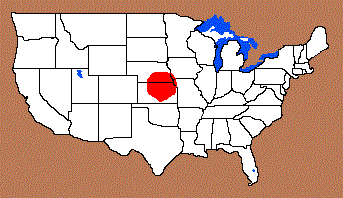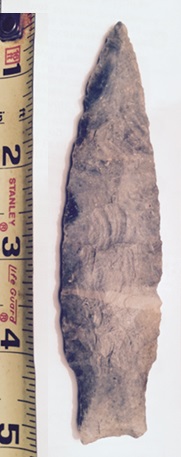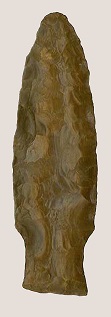Name Details:
Named By: Tom Witty Jr.
Named For: Mankers Creek Phase
Date Identified: 1969
Type Site: William Young Site (14Mio304), Morris County, Kansas
Munker's Creek
Cluster:
Commonly Utilized Material:
Date:
Cultural Period:
5,400 - 3,800 B.P.
Middle to Late Archaic
Middle Holocene to Neoglacial
Glacial Period:
Culture:
Outline is Representative of Size and Shape:
Description of Physical Characteristics and Flaking Pattern:
This is a large lanceolate expanding stem point with an elliptical cross section. The blade is long and narrow and has an excurvate shape with the tip curving in, becoming almost parallel on the edges, and
curving back in towards the shoulders. The shoulders are at an upward angle. The stem is most commonly slightly expanding, but may vary to straight and is slightly narrower than the maximum of the
blade width.. The base ranges from straight to slightly convex. This point has a random flaking
pattern.
Size Measurements: Total Length - 55 to
120 mm, Stem Length - 13 to 23 mm, Blade Width - 14 to 26
mm, Stem Width -8 to 14 mm
Distribution:
Distribution Comments:
This point is most commonly associated with the Flint Hills of Kansas and into the Osage Cuestas. This point may be found into central and eastern Nebraska.

Related / Associated Points:
Additional Comments:
For more examples please see link below:
Pictures:


Other points in this Cluster:
Point Validity: Valid Type
Witty was a distinguished archaeologist how helped conduct the River Basin Survey for the Kansas Historical Society. This type was named in a professional publication and has many
professional references. This is considered a valid type.
.
Age Details:
Radio carbon dates from the William Young site produced dates of 5,340 +/- 160, 3,100 +/- 400 and 3,400 +/- 500.
Pictures Provided By:
Mike Foster
Jim Peterson
References: (See Reference Page, Entry Number):
23, 30, 77
Munker's Creek Projectile Point, Munker's Creek Arrowhead




